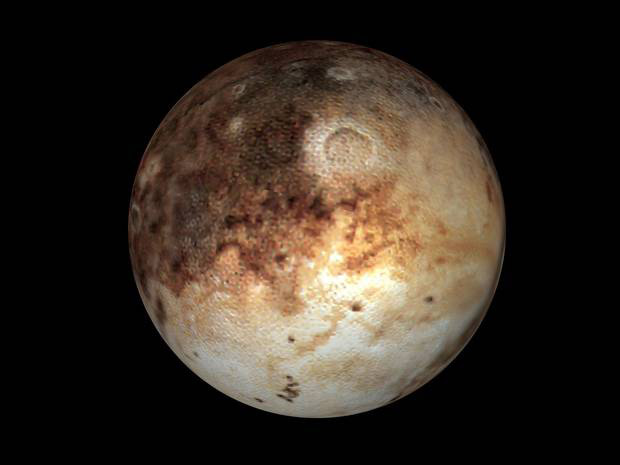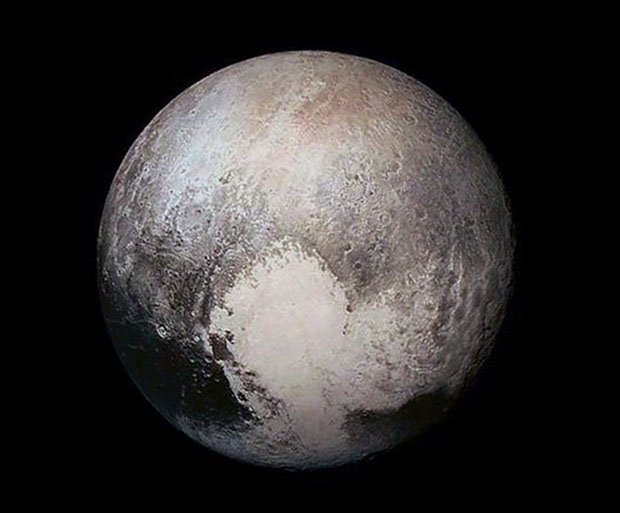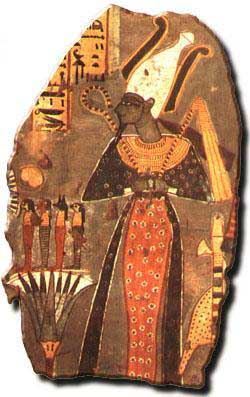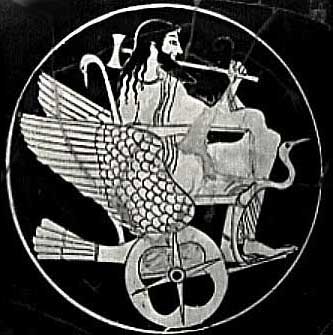



Pluto is the second-most massive known dwarf planet, after Eris. It is the largest object in the Kuiper belt and possibly the largest known trans-Neptunian object by volume. It is the tenth-most-massive known body directly orbiting the Sun. Pluto is primarily made of rock and ice.
Pluto was discovered in 1930 and hasnŐt completed an orbit around the sun since then. The dwarf planet is so far away from our star that an orbit will take it 248 years.
Pluto has five known moons: Charon (the largest, with a diameter just over half that of Pluto), Styx, Nix, Kerberos, and Hydra.] Pluto and Charon are sometimes considered a binary system because the barycenter of their orbits does not lie within either body. The IAU has not formalized a definition for binary dwarf planets, and Charon is officially classified as a moon of Pluto. Read more ....
How Pluto walks a tightrope between a stable and chaotic orbit Space.com - April 25, 2022
Pluto's continued existence owes much to the gravity of Jupiter and Neptune. Pluto is lucky to exist in the orbit that it does, according to new computer simulations that show how the dwarf planet skirts near a chaotic orbit that could potentially destroy the beloved world. The former ninth planet, now considered a dwarf planet, has an unusual orbit that is highly elongated and tilted with respect to the orbits of the planets. For 20 years of its 248-year journey around the sun, Pluto actually moves inside Neptune's orbit. That they never collide is a consequence of two properties of Pluto's orbit, known as azimuthal libration and latitude libration.
Methane ice dunes found on Pluto by Nasa spacecraft BBC - June 1, 2018
After an epic trek through the Solar System that took nearly a decade, New Horizons sped by at a speed of 58,536 km/h (36,373 mph), gathering data as it passed. In their study, the researchers explain how they studied pictures of a plain known as Sputnik Planitia, parts of which are covered with what look like fields of dunes. They are lying close to a range of mountains of water ice 5km high. The scientists conclude that the dunes are 0.4-1km apart and that they are made up of particles of methane ice between 200-300 micrometers in diameter - roughly the size of grains of sand.
Pluto 'has slushy ocean' below surface BBC - November 17, 2016
Pluto may harbor a slushy water ocean beneath its most prominent surface feature, known as the "heart". This could explain why part of the heart-shaped region - called Sputnik Planitia - is locked in alignment with Pluto's largest moon Charon. A viscous ocean beneath the icy crust could have acted as a heavy, irregular mass that rolled Pluto over, so that Sputnik Planitia was facing the moon. The findings are based on data from Nasa's New Horizons spacecraft. The space probe flew by the dwarf planet in July 2015 and is now headed into the Kuiper Belt, an icy region of the Solar System beyond Neptune's orbit. Sputnik Planitia is a circular region in the heart's left "ventricle" and is aligned almost exactly opposite Charon. In addition, Pluto and Charon are tidally locked, which results in Pluto and Charon always showing the same face to each other.
Video: Pluto's 'Heart' Hints at Deep, Underground Ocean Live Science - September 26, 2016
A new simulation of how Pluto got its "heart" suggests that the dwarf planet most likely has a deep ocean beneath its surface. Scientists have long suspected that Pluto has liquid water hidden underground. When NASA's New Horizons mission first set sail to the outskirts of the solar system, scientists were already planning to investigate whether the dwarf planet harbors water. When New Horizons flew past Pluto in July 2015 and beamed its observations back to Earth, scientists found evidence suggesting that Pluto had water at some point. However, they weren't sure whether Pluto's had an existing ocean, or if it had frozen solid over time.
Pluto is covered in a lot of frozen water CNN - January 30, 2016
Talk about an endless winter: Pluto has way more frozen water than scientists originally thought. The dwarf planet is coated with a large amount of ice, according to a new map using previously collected data from NASA's New Horizons spacecraft.
What caused the mysterious 'wormholes' on Pluto? Nasa baffled by pits and troughs hundreds of meters across and tens of meters deep Daily Mail - October 19, 2015
Each of the pits and troughs are typically hundreds of meters across and tens of meters deep. Were spotted in the area, informally known as Sputnik Planum. Believed they may have been caused by volatile ices such as solid nitrogen
New Horizons: Probe captures Pluto's blue hazes BBC - October 8, 2015
The New Horizons mission has returned its first color image of Pluto's atmospheric hazes and shows them to have a blue tinge. Like Earth, the dwarf has a predominantly nitrogen atmosphere (albeit much more sparse). But it is the interaction of this nitrogen with the Sun's ultraviolet light, in presence of another atmospheric constituent, methane, that is able to create the chunky haze particles.
A Plutonian Landscape NASA - September 18, 2015
This shadowy landscape of majestic mountains and icy plains stretches toward the horizon of a small, distant world. It was captured from a range of about 18,000 kilometers when New Horizons looked back toward Pluto, 15 minutes after the spacecraft's closest approach on July 14. The dramatic, low-angle, near-twilight scene follows rugged mountains still popularly known as Norgay Montes from foreground left, and Hillary Montes along the horizon, giving way to smooth Sputnik Planum at right. Layers of Pluto's tenuous atmosphere are also revealed in the backlit view. With a strangely familiar appearance, the frigid terrain likely includes ices of nitrogen and carbon monoxide with water-ice mountains rising up to 3,500 meters (11,000 feet). That's comparable in height to the majestic mountains of planet Earth. This Plutonian landscape is 380 kilometers (230 miles) across.
luto.
New Horizons reveals more mountains in Pluto's heart BBC - July 22, 2015
The latest images from the New Horizons spacecraft have revealed another range of ice mountains on Pluto. The frozen peaks were found on the lower-left edge of the dwarf world's "heart" and are 1-1.5km-high.
Video: New Horizons probe zooms into Pluto's plains BBC - July 17, 2015
The American space agency's New Horizons probe has returned further images of Pluto that include a view of the dwarf planet's strange icy plains. A region, which has been named after the Soviet Sputnik satellite, displays a flat terrain broken up into polygons. At the edges of these 20-30km-wide features are troughs filled with dark material and even small mounds.
Video: Pluto-Charon Fly-by: High Resolution Imagery Revealed By NASA Space.com - July 15, 2015
New Horizons: Images reveal ice mountains on Pluto BBC - July 15, 2015
Pluto has mountains made of ice that are as high as those in the Rockies, images from the New Horizons probe reveal. They also show signs of geological activity on Pluto and its moon Charon.
Pluto's hidden ocean PhysOrg - November 25, 2011
When NASA's New Horizons cruises by Pluto in 2015, the images it captures could help astronomers determine if an ocean is hiding under the frigid surface, opening the door to new possibilities for liquid water to exist on other bodies in the solar system. New research has not only concluded such an ocean is likely, but also has highlighted features the spacecraft could identify that could help confirm an oceanŐs existence.
'Non-planet' Pluto gets new class - "Plutoid" BBC - June 14, 2008
"Plutoid" is the word of the moment for astronomers. It is the new classification that has been sanctioned for the object that was formerly known as the "ninth planet". It is nearly two years since the International Astronomical Union (IAU) stripped Pluto of its former status as a "proper" planet. Now an IAU committee, meeting in Oslo, has suggested that small, nearly spherical objects orbiting beyond Neptune should carry the "plutoid" tag. As astronomy's official nomenclature organization, the IAU must approve all new names and classifications.

Pluto as Anubis the Egyptian god of the Dead.

Later he was superseded in that role by Osiris.


In Roman mythology, Pluto is the god of the underworld, and Charon is the ferryman across the river Styx, the moat into Pluto's realm. Though old and gray, Charon is strong and sturdy. Dressed in a short cloak, he chooses his passengers from among the multitudes of the dead that crowd the shore. Only those properly buried in the world above are chosen, and then only if they have the fare - a silver coin placed in the mouth of the corpse before burial.

Pluto, in Roman mythology, is the husband of Persephone.
Pluto, the lord of the underworld, represents the body intelligence of man; and the rape of Persephone is symbolic of the divine nature assaulted and defiled by the animal soul and dragged downward into the somber darkness of Hades, which is here used as a synonym for the material, or objective, sphere of consciousness.
In his Disquisitions upon the Painted Greek Vases, James Christie presents Meursius' version of the occurrences taking place during the nine days required for the enactment of the Greater Eleusinian Rites. The first day was that of general meeting, during which those to be initiated were questioned concerning their several qualifications.
The second day was spent in a procession to the sea, possibly for the submerging of an image of the presiding goddess. The third day was opened by the sacrifice of a mullet. On the fourth day the mystic basket containing certain sacred symbols was brought to Eleusis, accompainied by a number of female devotees carrying smaller baskets. On the evening of the fifth day there was a torch race, on the sixth a procession led by a statue of Iacchus, and on the seventh an athletic contest.
The eighth day was devoted to a repetition of the previous ceremonial for the benefit of any who might have been prevented from attending sooner. The ninth and last day was devoted to the deepest philosophical issues of the Eleusinia, during which an urn or jar - the symbol of Bacchus - was exhibited as an emblem of supreme importance.

Pluto in Greek mythology was Hades.


He was the son of the Titans Cronus (Saturn) and Rhea
and the brother of Zeus (Jupiter) and Poseidon (Neptune).
The Latin counterpart of the Greek god Hades, Pluto assisted his two brothers, Jupiter (Zeus) and Neptune, in overthrowing their father, Saturn.
The name Pluto means "rich one," and the Romans derived Dis (from dives, "rich"), their god of the dead, from Pluto. Pluto or Pluton or Hades was a god of both death and fertility or abundance.
In dividing the world among them, Jupiter chose the Earth and the heavens as his realm, Neptune became the ruler of the sea, and Pluto received as his kingdom the lower world, in which he ruled over the shades of the dead.
He was originally considered a fierce and unyielding god, deaf to prayers and unappeased by sacrifices. In later cults and popular belief the milder and more beneficent aspects of the god were stressed.
Believed to be the bestower of the blessings hidden in the Earth, such as mineral wealth and crops, Pluto was also known as Dis or Orcus, the giver of wealth.
Pluto's realm, the house of Hades is usually located beneath the Earth, though sometimes in the west.
Pluto represents transformation. Pluto is the planet of profound change, starting deep within us and moving toward the surface. It often touches upon the most sensitive psychological areas inside us. Once touched, we have no choice but to change and grow. Pluto is about death and rebirth, the transformation that comes from letting go of that which is unessential so that we can get to the core of things.
